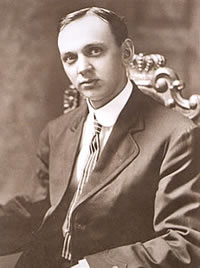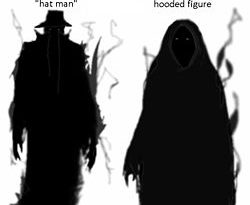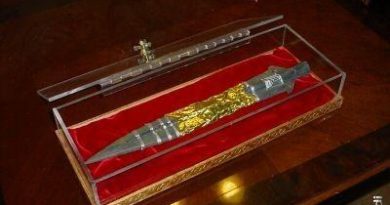The Sleeping Prophet
Source: http://en.wikipedia.org/wiki/Edgar_Cayce
http://www.dreamscape.com/morgana/phoebe.htm
http://www.edgarcayce.org/edgar-cayce1.html
Edgar Cayce was an American psychic who allegedly had the ability to give answers to questions on subjects such as healing or Atlantis while in a hypnotic trance. Though Cayce himself was a devout Christian and lived before the emergence of the New Age Movement, some believe he was the founder of the movement and influenced its teachings.
Cayce became a celebrity toward the end of his life and the publicity given to his prophecies has overshadowed what to him were usually considered the more important parts of his work, such as healing (the vast majority of his readings were given for people who were sick) and theology (Cayce was a lifelong, devout member of the Disciples of Christ). Skeptics challenge the statement that Cayce demonstrated psychic abilities, and traditional Christians also question his unorthodox answers on religious matters (such as reincarnation and Akashic records, although others accept his abilities as “God-given”).
Today there are thousands of Cayce students and more than 300 books written about Edgar Cayce. Members of Cayce’s organization, the Association for Research and Enlightenment (A.R.E.) exist worldwide and Edgar Cayce Centers are found in more than 35 countries.
For forty-three years of his adult life, Edgar Cayce demonstrated the uncanny ability to put himself into some kind of self-induced sleep state by lying down on a couch, closing his eyes, and folding his hands over his stomach. This state of relaxation and meditation enabled him to place his mind in contact with all time and space. From this state he could respond to questions as diverse as, “What are the secrets of the universe?” to “How can I remove a wart?” His responses to these questions came to be called “readings” and contain insights so valuable that even to this day individuals have found practical help for everything from maintaining a well-balanced diet and improving human relationships to overcoming life-threatening illnesses and experiencing a closer walk with God.
Though Cayce died more than half a century ago, the timeliness of the material in the readings is evidenced by approximately one dozen biographies and more than 300 titles that discuss various aspects of this man’s life and work. These books contain a corpus of information so valuable that even Edgar Cayce himself might have hesitated to predict their impact on the latter part of the twentieth century. Sixty years ago who could have known that terms such as “meditation,” “akashic records,” “spiritual growth,” “auras,” “soul mates,” and “holism” would become household words to hundreds of thousands? Further details about his life and work are explored in such classic works as There Is a River (1942) by Thomas Sugrue, The Sleeping Prophet (1967) by Jess Stearn, Many Mansions (1950) by Gina Cerminara, and Edgar Cayce-An American Prophet (2000) by Sidney Kirkpatrick.
Daily for over forty years of his adult life, Cayce would lie down on a couch with his hands folded over his stomach and allow himself to enter a self-induced sleep state. Then, provided with the name and location of an individual anywhere in the world he would speak in a normal voice and give answers to any questions about that person that he was asked. These answers, which came to be called “readings” were written down by a stenographer, who kept one copy on file and sent another to the person who had requested the information.
After completing seventh grade, Cayce left school in Hopkinsville to find work where he could. He worked on a farm, then in a shoestore, and later a bookstore. By the age of twenty-one, he had become the salesman for a wholesale stationery company. At about this time, Cayce contracted a throat problem which developed into aphonia — a total loss of voice. Doctors he approached were unable to help him, and Cayce began to regard his problem as incurable. He resorted to hypnosis, but this too had no useful effect until it occurred to Cayce to attempt re-entering the kind of hypnotic sleep which had enabled him to learn his schoolbooks when he was a boy. A hypnotist was found who was willing to give Cayce the necessary suggestion. Once in a trance, Cayce reportedly spoke in a clear voice, spelling out precisely what his symptoms were, and what should be done to cure them. Cayce had succeeded in curing himself and, in doing so, had launched himself on a lifelong career as a psychic diagnostician and healer.
It made no difference to Cayce whether his patient was sitting next to him in the same room or a total stranger living hundreds of miles away. His preparations for the health reading were always the same. As he himself described it, he would first loosen his clothing in order to have a perfectly freeflowing circulation. He would then lie on the couch in his office, with his head to the south, and his feet to the north. Placing his hands on his forehead between his eyes, he would wait a few moments until he received what he would call the go signal, a flash of brilliant white light. Cayce would then move his hands to his solar plexus, and fall into a trance. His wife would tell him the name and location of the patient, leaving out any mention of age, sex or physical problem. Cayce might pause a while before repeating the name and address until he had succeeded in ‘locating’ the patient and describing his or her condition. He would then prescribe medication and any other corrective measures, always ending his reading with the words: “We are through.”
His lifelong secretary, Gladys Davis, took down virtually all his readings, and they are recorded and indexed in the Association for Enlightenment and Research, established in Virginia in 1932 to study Cayce’s work. In all, he gave 14,879 readings, well over half of them for people concerned about their health. Over a period of forty-three years, he read for more than six thousand people. In 1933, when he had been exercising his powers for thirty-one years, he explained that he still understood very little about what he was doing. “Apparently,” he said, “I am one of the few who can lay aside their own personalities sufficiently to allow their souls to make this attunement to a universal source of knowledge — but I say this without any desire to brag about it. In fact I do not claim to possess anything that other individuals do not inherently possess. Really and truly, I do not believe there is a single individual that does not possess this same ability I have. I am certain that all human beings have much greater powers than they are ever conscious of — if they would only be willing to pay the price of detachment from self-interest that it takes to develop those abilities.”
Those who came into contact with Cayce were continually taken aback by the depth of medical knowledge he displayed during his sleep state. He would frequently recommend the use of drugs which were not generally known, not yet on the market, or which had long since passed out of use. Although he had a conscious knowledge only of the English language, Cayce is also estimated to have spoken in some two dozen foreign tongues while in a trance. The unconscious Cayce believed there was a cure for every health problem, including cancer, in nature, providing that cure could be found in time. He seldom advocated operations, believing that surgery was much overworked. Cayce took a holistic approach to health. He believed that a man was composed of body, mind and spirit, and that all three are one. He talked about consciousness in the cells of the body, each contributing to the total consciousness of the individual. Health, he indicated, would flow from a perfect harmony of body and mind. In accordance with the concept that we are what we eat, think and believe, Cayce would often urge his patients to improve their mental and spiritual outlook in order to regain their health.
His recommended treatments for patients included many forms of drugless healing, such as special baths, oils, heat, light, colonic irrigation, massage, diet and exercise. The knowledge of anatomy displayed by the sleeping Cayce flabbergasted more than one physician. The first to use Cayce in his own work was Doctor Wesley Ketchum of Hopkinsville. Ketchum wrote of Cayce; “His psychological terms and description of the nervous anatomy would do credit to any professor of nervous anatomy. There is no faltering in his speech and all his statements are clear and concise. He handles the most complex jawbreakers with as much ease as any Boston physician, which to me is quite wonderful in view of the fact that while in his normal state he is an illiterate man, especially along the lines of medicine, surgery and pharmacy, of which he knows nothing… in six important cases which had been diagnosed as strictly surgical he stated that no such condition existed, and outlined treatment which was followed with gratifying results in every case.”
With Ketchum’s persuasion, Cayce set up business in Hopkinsville as a psychic diagnostician, giving readings twice a day. Before long he was receiving sacks of mail every day from people anxious to avail themselves of his services.
Cayce’s prophetic powers often emerged during the readings he gave. In the main, his prophecies had little or nothing to do with the original request for a reading. Sometimes they were to do with financial matters, although Cayce’s readings stressed repeatedly that they should not be used for personal gain. Indeed Cayce found to his own cost early on in his career that if he did attempt to make money out of the information he received in his trances, he would suffer for it physically with headaches and stomach upsets. But other people were not so affected. Cayce gave advice to businessmen who were worried about the location of their holdings or the stability of their stocks and bonds. On occasion, he pointed to the location of oil wells, and correctly prophesied a real estate boom in the Norfolk-Newport area of the United States. Six months before the 1929 stockmarket crash he warned people to sell everything they owned. Many who had followed Cayce before failed to pay heed to his warning then, and lost all they had.
The sleeping prophet, as Cayce has been nicknamed, predicted the beginning and end of both the First and Second World Wars, and the lifting of the Depression in 1933. In the 1920s, he first warned of coming racial strife in the United States, and in 1939 he predicted the deaths of two presidents in office; “Ye are to have turmoils — ye are to have strife between capital and labor. Ye are to have a division in thy own land, before ye have the second of the Presidents that next will not live through his office… a mob rule!” President Franklin D. Roosevelt died in office in April 1945. In November 1963, President John F. Kennedy was assassinated in Dallas, Texas, when racial tensions in the United States were at their height. “Unless there is more give and take,”Cayce said, “consideration for those who produce, with better division of the excess profits from labor, there must be greater turmoil in the land.”
In October 1935, Cayce spoke of the coming holocaust in Europe. The Austrians and Germans, he said, and later the Japanese, would take sides. “Thus an unseen force, gradually growing, must result in an almost direct opposition to the Nazi, or Aryan theme. This will gradually produce a growth of animosities. And unless there is interference by what many call supernatural forces and influences — which are active in the affairs of nations and peoples — the whole world as it were… will be set on fire by militaristic groups and people who are for power expansion.”
Two of Cayce’s major predictions concerned the futures of China and the Soviet Union, the world’s great Communist giants. In 1944, he prophesied that China would one day be “the cradle of Christianity as applied in the lives of men.” Through Russia, he said “comes the hope of the world. Not in respect to what is sometimes termed Communism or Bolshevism — no! But freedom — freedom! That each man will live for his fellow man. The principle has been born there. It will take years for it to be crystallized; yet out of Russia comes again the hope of the world.” Russia, he said, would be guided by friendship with the United States. Its attempt to rule “not only the economic, but the mental and spiritual life” of its people was doomed to failure.
Cayce also predicted the possibility of a third world war. He spoke of strifes arising “near the Davis Straits,” and “in Libya, and in Egypt, in Ankara, and in Syria; through the straits around those areas above Australia, in the Indian Ocean and the Persian Gulf.” When asked in June 1943 whether it would be feasible to work towards an international currency or a stabilization of international exchange levels when the war had ended, Cayce replied that it would be a long, long time before this would happen. Indeed, he said, “there may be another war over just such conditions.”
Cayce believed in reincarnation. Each person, in his view, existed in a self-conscious form before birth and would exist again after death. As well as his health readings, Cayce gave many hundreds of so-called “life” readings, during which he would describe his subject’s past lives. A number of those readings referred to past incarnations in the legendary lost land of Atlantis. In all, Cayce referred to Atlantis no fewer than seven hundred times in his readings over a span of twenty years.
He maintained that Atlantis had a civilization which was technologically superior to our own, and that its last surviving islands had disappeared in the area of the Caribbean some ten thousand years ago. His most specifically timed forecast was that Atlantis would rise again in 1968 or 1969. Needless to say, Cayce was wrong on that count. [Note: However, it was in that timeframe that the “Bimini Road” was located in the Atlantic Ocean. Whether this is a “road” or “natural, geologic erosion” is being hotly debated.]
Cayce said the size of Atlantis was equal to “that of Europe, including Asia in Europe.” He saw visions of a continent which had gone through three major periods of division; the first two about 15,600 BCE, when the mainland was divided into islands. The three main islands Cayce named Poseida, Og and Aryan. He said the Atlanteans had constructed giant laser-like crystals for power plants, and that these had been responsible for the second destruction of the land. Cayce blamed the final destruction on the disintegration of the Atlantean culture through greed and lust. But before the legendary land disappeared under the waves, Cayce believed there was an exodus of many Atlanteans through Egypt and further afield. Cayce attributed history’s Great Flood in part to the sinking of the last huge remnants of Atlantis.
But Cayce’s most striking predictions — particularly in view of many other prophecies relating to the approaching end of the millennium — concern dramatic changes in the Earth’s surface in the period of 1958 to 1998. The cause of these he put down to a tilting in the Earth’s rotational axis which he said would begin in 1936.
The first sign of this change in the Earth’s core would be the “breaking up of some conditions” in the South Pacific and “sinking or rising” in the Mediterranean or Etna area. Cayce forecast that, by the end of the century, New York, Los Angeles and San Francisco would be destroyed. He said that “the greater portion of Japan must go into the sea” at this time, and that northern Europe would be “changed as in the twinkling of an eye.” In 1941, Cayce predicted that lands would appear in the Atlantic and the Pacific in the coming years, and that “the coastline now of many a land will be the bed of the ocean. Even many of the battlefields of (1941) will be ocean, will be the sea, the bays, the lands over which the new order will carry on their trade as with one another.”
“Watch New York, Connecticut and the like. Many portions of the east coast will be disturbed, as well as many portions of the west coast, as well as the central portion of the United States. Los Angeles, San Francisco, most of all these will be among those that will be destroyed before New York, or New York City itself, will in the main disappear. This will be another generation though, here; while the southern portions of Carolina, Georgia, these will disappear. This will be much sooner. The waters of the Great Lakes will empty into the Gulf of Mexico.”
Cayce prophesied that the Earth’s axis would be shifted by the year 2001, bringing on reversals in climate, “so that where there has been a frigid or semi-tropical climate, there will be a more tropical one, and moss and fern will grow.” By this time, he indicated, a new cycle would begin.
Edgar Cayce’s last reading on 17 September 1944, was for himself. He was now receiving thousands of requests for assistance. His own readings had repeatedly warned him that he should not try to undertake more than two sessions a day. But many of the letters he received were from mothers worried about their sons on the battlefields, and Cayce felt he could not refuse them his aid. His last reading told him that the time had come for him to stop working and rest. On New Year’s Day, 1945, he announced that he would be buried on the fifth of January. He was right.
Ten years earlier, Cayce had written a brief account of his work. In it, he said, “The life of a person endowed with such powers is not easy. For more than forty years now I have been giving readings to those who came seeking help. Thirty-five years ago the jeers, scorn and laughter were even louder than today. I have faced the laughter of ignorant crowds, the withering scorn of tabloid headlines, and the cold smirk of self-satisfied intellectuals. But I have also known the wordless happiness of little children who have been helped, the gratitude of fathers and mothers and friends… I believe that the attitude of the scientific world is gradually changing towards these subjects.”



